Tips for Choosing an HVLP gun and nozzle
HVLP spray guns are becoming increasingly popular as DIY tools these days. They're convenient, easy to use, and versatile. If you are creative and skilled enough in using this tool, you can paint just about anything yourself. Compared to conventional object painting, using an HVLP sprayer would not only give you satisfactory results, but also allow you to complete projects with ease in a matter of minutes.
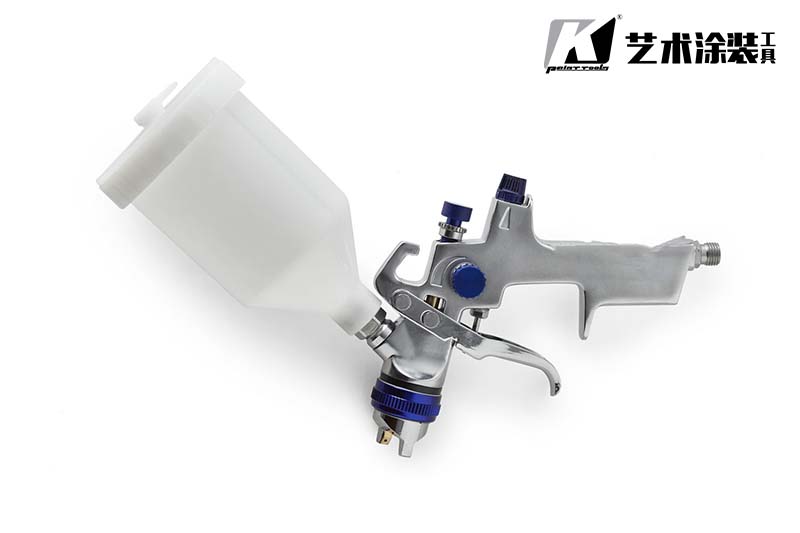
What are the HVLP paint guns?
When it's time to paint, a wide range of possibilities opens up to the different tools offered today to spread the chosen paint or coating on the desired surface. From hand tools, such as the ever faithful brush and the slightly more sophisticated roller, to systems propelled by power, both electrical and pneumatic, the application of all these elements is vast and varied.
In Of Machines and Tools we have especially addressed the field of electric painting tools and their accessories. In this way, we provide a comprehensive introduction to electric paint sprayers and their maintenance, and also introduce a useful component such as paint mixer and its applications.
We are now going to turn our attention to air-powered painting tools, that is, those that generally have a gun design and that require a compressor or a turbine to work, as we will see below. Paint spray guns or just paint guns make it easy to finish any paint job in a fraction of the time and without having to worry about dirty rollers, brush lines, dripping paint, or the hassle of trying to evenly paint various surfaces.
Depending on, among other things, the mechanism of operation and the finish obtained, air-driven or pneumatic spray guns are subdivided into three groups:
Conventional high pressure guns
HVLP (high volume low pressure) guns
LVMP/LVLP (Low Volume Medium Pressure/Low Volume Low Pressure) Guns
While the DIYer is often satisfied with a conventional spray gun that he or she will use a few times a year, HVLP (high volume, low pressure) paint sprayers are much more popular with professionals who use them frequently, and their cost is lower. Easily absorbs with the first jobs done. So, let's dig into the details about these highly sought after models to get to know them a little more.
What is an HVLP spray gun?
Intended for the professional user, HVLP paint spray guns are ideal paint spray equipment for use in touch-ups, finishing jobs, furniture staining, cabinet painting, and any detailed application where high precision, speed, and precision are required. perfectly smooth finish.
And why are they ideal for this type of requirement?
Because each of the working conditions of these devices brings its benefit:
High Volume – This means that a higher volume of paint comes out of the gun nozzle and impacts the surface to be painted.
Low Pressure – This means that paint atomization is reduced, resulting in less overspray, less waste and less pollution.
Therefore, if we combine these characteristics, the result is a more professional finish and a lower cost of painting.
Put another way, and as we see in the video, by using a higher paint volume and lower air pressure, HVLP guns can reliably control even paint distribution. This will translate directly into savings, both money by minimizing paint waste due to overspray and material splatter, and time by not having to refine paint lines left by other devices.
How does an HVLP spray gun work?
The basic principle of HVLP guns is to "atomize" the paint, which means that when it comes into contact with the air stream released by the gun, the paint separates into small particles as the air is expelled from the nozzle.
All guns come with unlimited paint fan formation control, from small to large (eg 180 to 250mm), as well as spray density controls, from a mist to a thick layer. They also feature airflow and paint volume controls, an approximately 600ml capacity paint reservoir, an air inlet and a nozzle that help control the pressure and dispersion of the paint being sprayed.
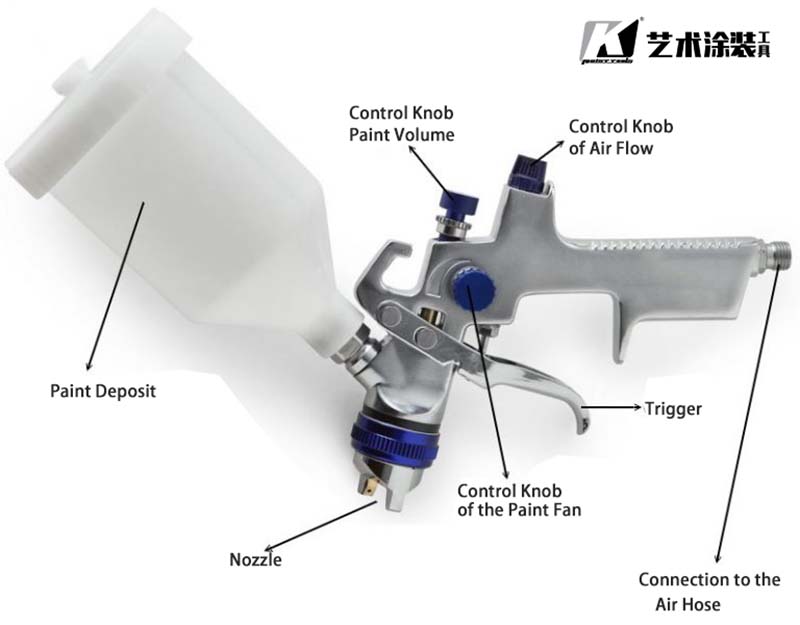
Parts of an HVLP Paint Spray Gun
Operation is simple: when the gun trigger is pressed, the paint is released into the air stream, atomized and fired through the nozzle at the desired pressure and spray pattern. The result of a correctly configured HVLP gun is a fast and even coat of paint, with very little material waste.
However. What is the paint propulsion mechanism in HVLP spray guns?
Actually, this mechanism can be of two types: through an air compressor capable of producing about 25 psi to propel the paint. They are the most common because they are the cheapest, but depending on the work needs, they may not be efficient enough.
Using a turbine system to produce large volumes of air, but at a lower pressure: approximately 6 psi. These types of sprayers are more expensive, but they are also more efficient, and since they do not require a separate purchase of an air compressor, they can mean cost savings.
What are the applications of HVLP spray guns?
Precisely because it is the best-selling type of paint spray gun, the professional, industrial and even domestic application of HVLP guns is wide. Let's look at some examples.
a) Car paint renovation
In this area, HVLP sprayers have replaced the alternatives on the market and have become the best tool for body shops and automotive paint shops. They can be used to spread the base coat in the original paint renovation, as well as used for the color coat and the clear or varnish coat. Also, these guns are more suitable than other options because there is no need to buff the clear coat. And while the HVLP sprayer is intended for professionals, DIY enthusiasts can also use it to refinish their car paint in the home garage.
b) Marine finishes
The proper finish is essential for marine vessels because the coating provides corrosion protection and increases curb appeal. HVLP sprayer can work on metal surfaces and wood surfaces. When the nozzle is correctly adjusted, the coverage of each surface is ideal. When using an HVLP spray gun for marine paint, it is important to ensure that the distance between the surface and the spray gun is kept to a minimum, around 10 cm. This will reduce overspray and provide good coverage. Reducing overspray will minimize the amount of paint particles in the air.
c) Painting of buildings
While HVLP sprayers are most popular for painting transportation structures, they can also be used for architectural work. They are ideal for painting different characteristics of buildings because the layer obtained is uniform. Also, almost all types of coatings can be applied, as long as the proper nozzle is used. For example, the HVLP gun can be used to apply even coats of caulking to drywall construction. The device can be used for both indoor and outdoor applications and again no overspray can lead to huge savings.
d) Furniture finishing
This can be a tedious task because a high level of precision is required. Without the proper tools, the coatings will not be uniform and the visual effect will be washed out. HVLP sprayers are suitable for this task because the paint is propelled at low pressure. This lower application pressure means the gun can be held closer to the furniture surface and consequently the coating can be spread more precisely, giving better coverage than alternative methods.
Advantages and disadvantages of HVLP guns
Like any tool, HVLP guns have a number of advantages, although they can also have their drawbacks. It is important to know both in order to make an intelligent decision later. In the following image we summarize the most relevant.
Advantage
Less overspray: thanks to the greater volume of material that is displaced, most of it ends up on the surface to be painted. This means saving money on paint by using less, which increases the efficiency of HVLP guns.
Transfer Efficiency: Less paint is wasted in the process and a greater distance is covered between the nozzle and the surface to be painted using less paint.
Cleaner Technology: Less waste means a cleaner work environment. More paint reaches the surface to be painted and not the surrounding area, saving time on subsequent cleanup.
More friendly to the environment: Although face masks should be used as a precaution, with an HVLP gun, the user is exposed to less dangerous vapors due to the high volumes that are sprayed.
Precision: With different types of gun or tip, HVLP technology can be used for some very delicate touch-up jobs.
Disadvantages
Paint Texture: Highly viscous paints cannot be used in HVLP guns as these require thinner coatings for better low pressure spray quality.
Cost: they are more expensive than any other, since they provide excellent quality coverage.
Less coverage: HVLP guns cover less area than conventional high pressure guns and are slower if large areas are planned to be sprayed. This is due to the combination of high volume and low pressure. The larger amount of material is heavier to displace, and therefore spreads over a smaller area. They are rather considered finishing tools.
Portability: Unless they incorporate a turbine propulsion mechanism, they require the use of an air compressor, limiting their easy transfer from one place to another.
Do I need an HVLP spray gun for my job?
This is a question whose affirmative or negative answer will depend on a series of factors that we must previously consider. Professionals know that the biggest cost in their industry is labor and time. HVLP sprayers were precisely designed to save time, increase efficiency, reduce overspray and, thanks to the uniformity of the spread paint layer, minimize the possibility of having to spray an area more than once or dealing with splashes. and unsightly lines.
As if that were not enough, they have a long useful life despite intense use and that is due to the longevity provided by working at low pressure. However, like any technological advance, good practice is required. HVLP gun novices often complain of uneven “orange peel” finishes. But with enough experience, very soon you might even be surprised at how many uses an HVLP sprayer has.
The home user can start with a conventional high pressure gun and then evaluate, based on their requirements, whether it would be convenient to replace it with an HVLP. Painting a house, for example, is one of the most embarrassing tasks that many DIY enthusiasts would rather not do themselves.
But it is not necessary to spend a lot of money to acquire an HVLP gun that suits the budget and needs of each user. This will make it possible to achieve identical or even better results than if you hired a professional painter to do the job.
It is also important to consider what type of coatings are going to be sprayed. Both HVLP and conventional guns can handle a wide variety of materials, but high-viscosity coatings such as lacquers, alkyds, sealants, etc. may require conventional guns instead of HVLP.
Therefore, we must first consider the use, the frequency of use and the viscosity of the coating with which we will work. Once we have these options resolved and have decided on an HVLP pistol, a second stage will follow on how to select it correctly
What is a paint gun like and how many types are there?
There are different tools for working with paint. The paint gun —also incorrectly called an airbrush— is a tool that works based on a stream of compressed air which, due to the principle of the Venturi tube, atomizes the liquid contained in a tank for this purpose; In this way, the liquid (which can be paint but also oil and others) is atomized and can be applied uniformly on any surface, thus achieving great neatness and finish. Although there are paint guns that work based on other drive methods (electromechanical for example), in this note we will see the pneumatic ones, powered by compressed air.
It is a tool that projects atomized paint, under pressure, through different interchangeable nozzles. It consists of a body -generally metallic-, a trigger, a nozzle where the nozzle is screwed on, a container to place the paint there, and a hose for compressed air. Some advanced models include a pressure gauge to know the air pressure. Pressing the trigger opens an internal valve that regulates the entry of compressed air (and its flow) thus allowing to regulate the exit speed of the paint, and its quantity.
What is the difference between a paint sprayer gun and an airbrush?
Airbrush. Note that the tool is shaped like a pen, as it is intended for detailed work, unlike paint guns.
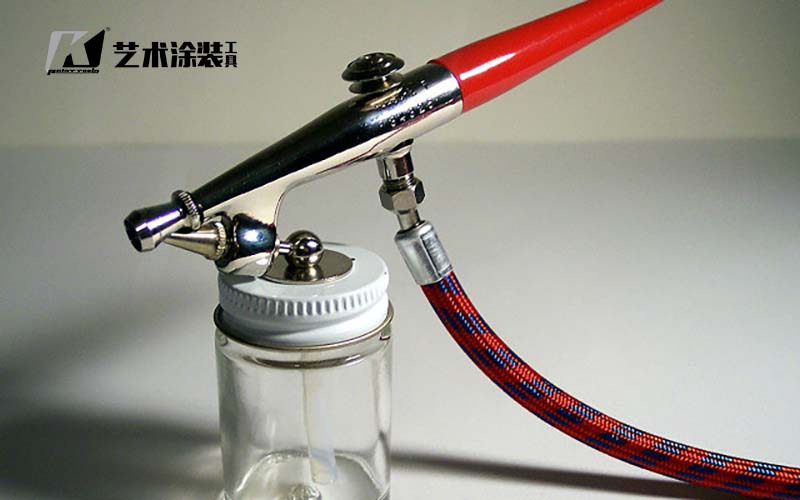
Airbrush
Although the principle of operation is identical in both tools, paint guns are prepared to receive a higher pressure than that required in airbrushes. Airbrushes are designed to perform artistic work, so they are smaller and have an elongated shape, similar to that of a pen. Paint spray guns, designed for more intensive work, have a gun shape, which makes them more anatomical.
How many types are there?
There are two main types of technology to achieve paint atomization: by air current (pneumatic) and by generating an electrostatic field. There are also other types, as we will see a little later.
Pneumatic paint spray guns
Pneumatic paint guns are classified according to the pressure and volume they handle, although it is very rare to find a paint gun that works in a high pressure regime, since it would waste a large amount of paint as it remains suspended in the atmosphere ( something that also causes serious health problems).
These guns require the use of a canister air compressor in order to use them; In some cases, the same tool includes a compressor specially designed to deliver the air at the necessary working pressure, which makes the tank unnecessary. In the classification by volume there are two main categories: HVLP and LVLP. In both cases, to qualify as such, the pressure must not exceed 690 hPa (approximately 10 psi).
Classification by volume of paint per minute
1.HVLP guns
They stand for High Volume, Low Pressure. The gun, working at low pressure, allows a high volume of paint to be applied, which implies a higher flow rate (around 2.9 cubic meters per minute) and, therefore, greater consumption.
The advantage of this type of spray gun is that they allow a given area to be painted in less time than the use of LVLP spray guns would require, although consumption will be slightly higher. They are especially useful for large workshops, where production speed is more important than consumption.
2.LVLP guns
In this case, the acronyms mean Low Volume, Low Pressure (low volume, low pressure), and those that work with pressures not greater than 690 hPa (10 psi) and develop a flow rate not greater than 2.9 are classified as such. cubic meter per minute. This type of paint guns allows you to save paint by sacrificing work speed. They are indicated for work at home or in workshops with modest production requirements.
Another important factor is the location of the paint deposit. Some models, as we saw before, work using the Venturi principle: the passage of air through a tube placed perpendicular to another causes a vacuum in the latter, thus dragging the liquid contained below, atomizing it at the outlet of the tube. nozzle. In the models whose deposit is above the nozzle, the paint descends due to the action of gravity. These paint guns are used when the paint is too viscous to be aspirated.
3.Electrostatic paint guns
These paint guns achieve atomization using a different principle than the Venturi tube: inside a plunger, paint droplets become electrically charged, repelling each other. This allows them to come out evenly through the nozzle when compressed air is applied. Some models completely dispense with pressurized air, achieving the exit of the paint by means of a cylinder that offers pressure to the liquid, pushing it through the nozzle; the paint, electrically charged, causes the drops to be separated.
4.Other types
to piston
This type of paint gun —used mostly in heavy industry such as shipbuilding— uses a piston to strongly compress the paint and force it out of the nozzles, where atomization occurs. The paint is thus pressurized, without the need to use compressed air to propel it. This allows better adherence, especially on uneven surfaces.
Paint booths
They are integral systems where the paint is applied inside a sealed and pressurized chamber. The greatest use of this application is in the automotive industry, where it is extremely important that the finish is perfect and durable. Although they are not technically considered spray guns (since they take up almost the space of a small garage), we include them here for comparison.
Automated production lines
In these systems, the paint gun is operated by a fully automated system, without the need for an operator to apply the paint manually. Its use occurs exclusively in medium and high production factories, where it is extremely important to control the homogeneity and economy of the process as much as possible.
Nozzles
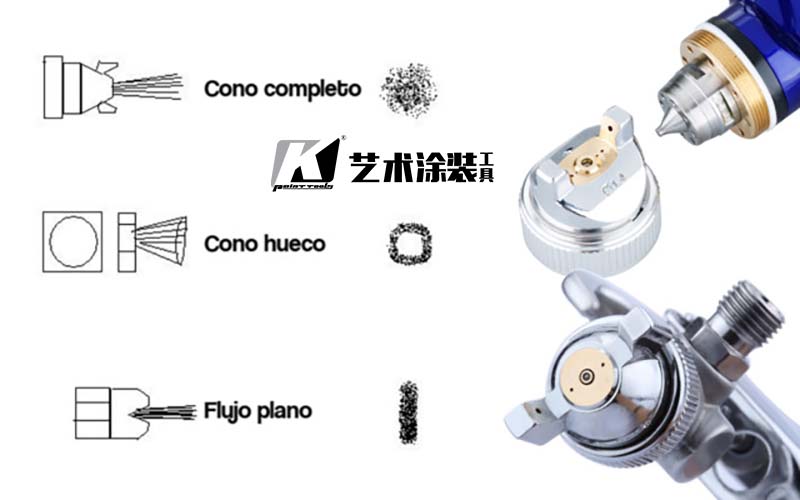
spray gun nozzles for painting
Just as important as the position of the reservoir is the shape of the nozzle used to apply the paint. In the photograph above we can see the three most common.
Tips for choosing an HVLP gun and nozzle
Among the most modern tools to make our painting job easier, HVLP guns are an excellent addition to the home or workshop. With an HVLP spray gun it is possible to apply a coating four times faster than using a roller and ten times faster than a brush. However, beyond saving time, these tools also achieve a smoother finish, free from unsightly brush marks, as well as very easy application in difficult or confined areas.
In other words, an HVLP gun brings together a series of extremely interesting features, such as:
1. High transfer efficiency
2. Minimal bounce
3. Low fluid pressure means low wear
4. Moisture free atomizing air
5. Controlled spraying on most materials
6. Three spray patterns available from 1/4″ to 12″
7. Less prep and cleanup work
8. Affordable cost
9. Low maintenance
10.Portability
11.Reduction of material consumption by 40%
12Less work time
These advantages ensure a wide range of applications in, for example, automobiles, boats, general touch-up work, general maintenance, appliances, wood and wicker furniture and cabinets, patio furniture, door jambs, frames, elevator doors, etc. folding doors, shutters and shutter doors, partition panels, porcelain, gutters, pipes, multi-color finishes, and many others.
However, as we have pointed out on other occasions, it is crucial that when purchasing an HVLP spray gun we choose a unit that meets our painting needs. In this article we will present some points that will help us understand what we should look for and, therefore, refine our list of priorities.
How to choose an HVLP spray gun?
Like any tool, we have to think about what is most relevant when purchasing an HVLP spray gun. And in this case, the most relevant can be summarized in two aspects.
a) Reliability and functionality
An HVLP gun is a device that we will always need available to work, regardless of the size of our project. Therefore, it is necessary to think about some key questions. For example:
What will be the frequency of use of the gun?
How will it be used?
What materials will be used?
Is it important to have diverse controls in the tool?
Must it be versatile?
Can the container or cup hold the amount of paint needed for each coat?
Is it difficult to remove the cup?
If the gun gets stuck for some reason, is there a problem taking each part apart?
It is also extremely important to thoroughly investigate the nozzle, which is designed to effectively eliminate overspray and use less paint on larger surfaces. We will deal with this fundamental aspect below.
b) Budget to choose an HVLP gun
This is one of the most important factors and will most likely be the deciding factor that will determine the purchase. However, there is no need to spend a lot of money on an HVLP gun that will give us an excellent finish, since most HVLPs are relatively cheap and regardless of our budget, we can always find one that suits our needs.
If you're a professional, then you'll want to put in a little more effort and invest in a high-end HVLP spray gun. No contractor would like to have a tool problem in the middle of a routine job, which would be a waste of time and money. On the other hand, for individuals who simply need a reliable HVLP gun for a small home task or to refinish their car, for example, an inexpensive low-end HVLP unit will suffice.
Nozzle Considerations
Choosing the correct tip size for our HVLP gun is critical as it determines the type of material that can be sprayed with the gun. The larger the nozzle size, the more viscous and heavier the material that can be used.
For a correct choice of nozzle size, let's first know what are the typical components of a nozzle, which manufacturers generally offer as spare parts and/or accessories for their HVLP guns. A typical nozzle assembly includes a needle, fluid tip, and air cap, and is mounted to the gun as shown in the figure below.
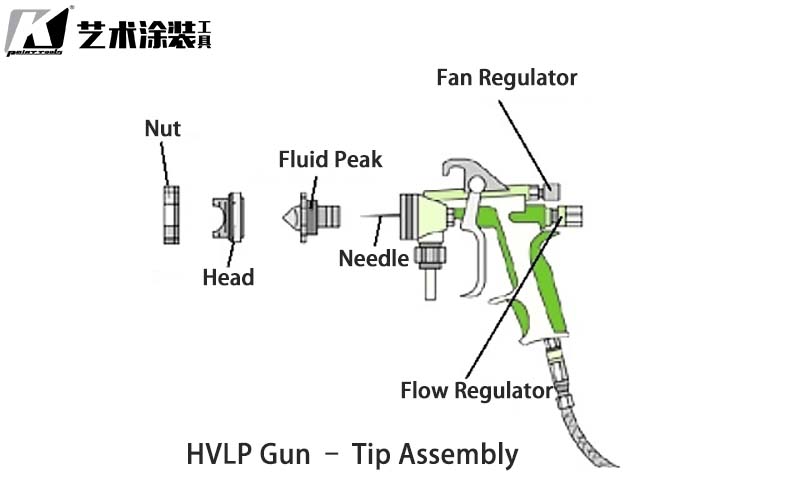
HVLP Gun – Tip Assembly
The proper functioning of these three components ensures a maximum degree of atomization and an excellent quality of finish. The irregular supply of both air and paint will cause defective fans and poor quality finishes. In the figure below we see the components of the kit as it is marketed by the manufacturer and we are going to dwell on how important we should look at each of these components.
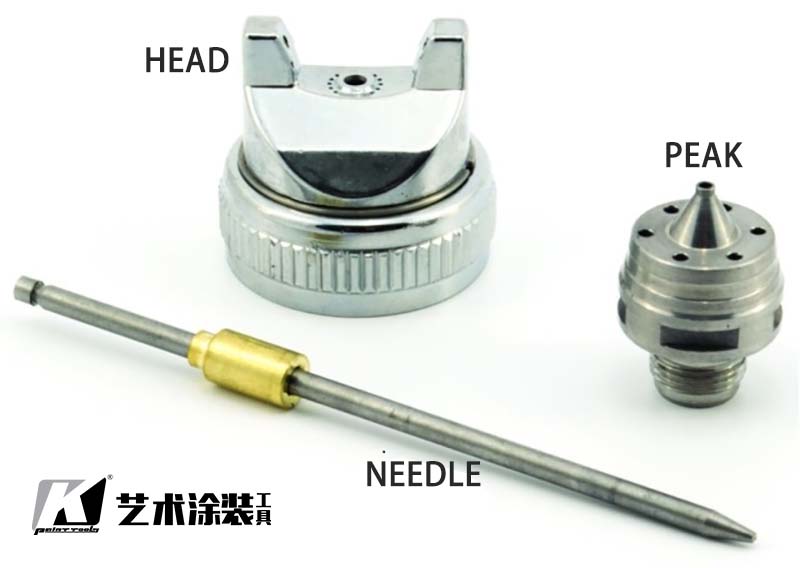
HVLP Gun – Kit components on the market
The air cap is the most important component of a paint spray gun and it comes in several types. In some cases it is made of bronze and its function is to control and distribute the compressed air in the coating material to be sprayed. The fluid tip is made of high quality stainless steel and together with the air cap it completes the atomizing air section of the gun. Its size is indicated in millimeters, with typical measurements of 1.4, 1.7 and 2.0 mm, and its function is to control the output of the material.
The needle is also made of high quality stainless steel, and together with the nozzle it completes the fluid control section of the gun. The needle controls the output of the material by means of the trigger, which moves it backwards or forwards. There are many guide tables about the most suitable size of the nozzle for the material to be sprayed. While the final recommendation will depend on the manufacturer of the material, we have provided a table below to guide us in our choice.
| Beak Size (mm) | General Use | Examples |
0,5 – 0,8 | Separator films, PVA films, very fine mists | Curing, custom industrial stains, dyes, bleaches |
0,9 – 1,3 | Clear coats, super fine finishes | Automotive clear coat, tub finishes, enamels, nitrocellulose lacquer, varnishes, urethanes, interior latex |
1,4 – 1,5 | Base coats, single coats | Automotive Basecoat, Adhesives, Epoxies, Direct-to-Metal Coatings, Heavy Duty Urethanes, Direct-to-Metal Water Contact Coatings, Interior and Exterior Latex, High-Build Primers, Boat Bottom Paint |
1,6 – 1,8 | General Purpose: Light to High Viscosity Materials, Primers | Exterior latex, zinc coatings, multicolor coatings |
2,0 – 2,4 | Gelcoats and resins: viscous resins (not paints) | Multi-color coatings, custom industrial coatings |
2,5 o más | Gelcoats and resins: viscous resins (not paints) | Boat Bottom Antifouling Coatings, Custom Industrial Coatings |
Low-cost spray guns incorporate plastic tips and heads. While these produce finer spray patterns, the bronze heads achieve a better level of atomization and are removable, easy to clean and resistant to wear, extending tool life. Most high-end HVLP guns come with a brass head and nozzle. The mid-range ones usually have a bronze head with stainless steel needles and spikes.
HVLP Gun Considerations
a) Spray patterns
When comparing one brand of HVLP gun to another, let's examine the spray patterns of each. The spray pattern is the way fine particles of paint or other material come out. Typically we will find three patterns: round, horizontal and vertical. Although the latter two are simply different directions for the same spray fan, having both available means that you can go from spraying a fan of say 180mm width to a fan of the same width by moving up and down without turning. the gun; instead, a knob on the mouthpiece is simply turned.
b) Adjustability and versatility
One of the main advantages of HVLP guns is their control over the result. All users want to add a touch of professionalism to their work. A gun that allows you to change spray patterns by controlling spray flow and density will ensure distinctive results. To the extent that our budget allows, choose an HVLP gun with high flexibility, that is, with adjustable spray characteristics (for example, a two-step trigger) and regulation of the width of the material fan, for example, between 180 and 250mm It would also be convenient.
If our work calls for it, that the pistol we choose is compatible with various tip sizes (for example, 1.7, 2.0, 2.2 and/or 2.5 mm, in addition to the standard of 1.4mm usually built into the tool by default), and if so, purchase some of these extra bits. The greater the versatility in terms of tip sizes, the more finishes we can specify and achieve. It is also possible to investigate whether extensions can be fitted to the peaks, a useful feature for painting high ceilings, hallways and hard-to-reach spaces.
c) Dilution
A good HVLP gun should spray evenly, even on viscous materials without thinning. The dilution of the paint or other material to be applied not only implies a waste of time, but also creates a messy effect on the sprayed surface.
d) Characteristics of the material tank or cup
Let's examine the capacity of the paint cup in view of the frequency with which we will have to refill it. Most HVLP guns on the market have a 600 cc cup, but there are manufacturers that offer available sizes of 500 and 750 cc. For its part, the material of the cup is commonly plastic (resistant nylon), although some models have an aluminum tank, which allows use with materials that could attack plastic.
e) Hose characteristics
If the model of HVLP gun that interests us comes with the compressor hose included, let's check that its length is reasonable for our needs. For example, a hose with a minimum length of 7.5 m may be long enough to carry out work in awkward spaces, without having to worry about the distance to the compressor.
If, on the other hand, we must purchase the hose separately, look for a good quality one, with a 1/4″ male thread, adaptable to almost all HVLP guns on the market, a bronze nozzle with a 1/4″ BSPT thread, and that supports the working pressure of the gun that we will choose, which generally, depending on the manufacturer and model, is between 2.0 and 5.0 bars, with maximum pressures that can exceed 8 bars. We can choose different lengths of hose, the most common being 7.5 m and 15 m.
f) Outdoor use
A long hose will also allow our HVLP gun to be used outdoors, for example to paint a fence, shed or other garden structure. But first, it is essential to make sure that the pistol we choose is suitable for outdoor use. Most of them are, but it never hurts to make sure of it before making a mistake that would ultimately be extremely costly.
g) Cleaning of HVLP guns
Keeping the HVLP gun clean after use is essential to our work and to prolonging the life of the tool. Therefore, a unit that can be disassembled for easy cleaning will be highly desirable. Many manufacturers ship their HVLP equipment with a cleaning tool kit, which includes a wrench for disassembly, brush and other accessories.
h) After-sales service
Finally, regardless of the model of HVLP gun that we are going to choose, always make sure that there are spare parts available (for example, tips, heads, needles, reservoirs or cups, etc.) and that at all times we can count on a adequate customer service and efficient technical service, characteristics that are only provided if we acquire the product of a recognized brand.















